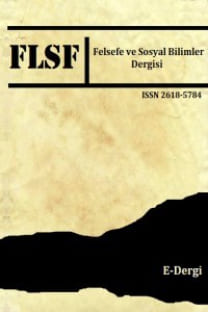DUYULAR, DOKUNMA VE VÜCUT BİLİNCİ
Eldeki yazı felsefe ve psikoloji tarihinde yüksek duyular diye adlandırılan görme ve işitme duyuları ile alçak duyular diye adlandırılan koklama, tatma, dokunma duyularını konu etmektedir. Yüksek duyulara özgü algısal herhangi bir işlevden yoksun görsel ve işitsel duyumları kabul etmemize izin veren istisnai durumların da varlığına işaret ederek duyum ile algı arasındaki ayrımı yüksek duyulara uygulayacağız. Böyle istisnai durumlarda görme ve işitme duyusuna tıpkı alçak duyumlardaki gibi bedende yer-tutan bir bilinç içeriğinin karşılık geldiğini ileri süreceğiz. Duyuların ayrıştırılması üzerinde kısaca duran bölümden sonra dokunma duyusuna yoğunlaşmak suretiyle pasif dokunmayı aktif dokunmadan ayırt edeceğiz. Görme duyusunun tahakkümünden kurtulduğunda dokunma duyusu özerkleşmeye ve ayrıcalık kazanmaya başlayacağından, “ortak duyumsanırlar” hipotezi ciddi eleştirilere açık hale gelir. Vücut bilincini oluşturan, pasif dokunmaya ait dokunsal hassasiyettir.
Anahtar Kelimeler:
duyular, dokunma, vücut bilinci, fenomenoloji
The present paper discusses the senses such as vision and audition which are called in the history of philosophy and psychology superior senses as well as the senses such as smell, taste and touch, viz. the so-called inferior senses. By pointing to the exceptional cases of vision and audition that permit us to accept the visual and auditory sensations deprived of any perceptual function proper to the superior senses, we apply the distinction between perception and sensation to the superior senses. We claim that, just like the inferior senses, these exceptional cases have a bodily localized conscious content corresponding to vision and audition. After the section on the differentiation of the senses, we focus on the sense of touch and clarify the distinction between active touch and passive touch. The fact that the sense of touch, when emancipated from the domination of vision, becomes more autonomous and gains a privilege makes the hypothesis of “common sensibles” open to serious criticism. Bodily consciousness is made up of tactile sensibility pertaining to passive touch.
Keywords:
senses, touch, bodily consciousness, phenomenology,
___
- Avant, Lloyd L., “Vision in the Ganzfeld”, Psychological Bulletin, 64 (4), 1965, 246-258
- Cohen, Walter, “Spatial and Textural Characteristics of the Ganzfeld”, American Journal of Psychology, 76, 1957, 403-410.
- Cole, Jonathan, Pride and a Daily Marathon, The MIT Press, Cambridge Mass, 1995.
- de Vignemont, Frédérique & Olivier Massin, Olivier, “Touch”, in Oxford Handbook of Philosophy of Perception, Oxford University Press Oxford, 2015, 294-313.
- de Vignemont, Frédérique , “A Multimodal Conception of Bodily Awareness”, Mind, Vol.123. No: 492, 2014, 989-1020.
- Declerck, Gunnar, Résistance et tangibilité, Essai sur l’origine phénoménologique des corps, Le Cercle Herméneutique Editeur, Paris, 2014.
- Fulkerson, Mathew, “The Unity of Haptic Touch”, Philosophical Psychology, 24 (4), 2011, 493-511.
- Fulkerson, Mathew, "What Counts as Touch?”, in Perception and its Modalities (ed. Dustin Stokes, Mohan Matthen ve Stephen Biggs), Oxford University Press, Oxford, 2014, 191-204.
- Gibson, James J., “Observations on Active Touch”, Psychological Review, 69 (6), 1962, 477-491.
- Henry, Michel, lncarnation, Une philosophie de la chair, Seuil, Paris, 2000.
- Husserl, Edmund, Ideen zu einer reinen Phänomenologie und phänomenologischen Philosophie. Zweites Buch. Phänomenologische Untersuchungen zur Konstitution (ed. Marly Biemel), Martinus Nijhoff, Den Haag, 1952.
- Husserl, Edmund, Ideen zu einer reinen Phänomenologie und phänomenologischen Philosophie. Erstes Buch, (ed. Karl Schuhmann), Martinus Nijhoff, Den Haag, 1976.
- Husserl, Edmund, Ms. D 13 I/6a. ( Yayımlanmamış Elyazması), Husserl-Archiv, Köln.
- Husserl, Edmund, Zur Phänomenologie der Intersubjektivität: Erster Teil: 1905- 1920 (ed. Iso Kern), Martinus Nijhoff, Den Haag, 1973.
- Katz, David, Der Aufbau der Tastwelt, Verlag von Ambrosius Barth, Leibzig, 1925.
- Mattens, Filip, “Perception and Representation: Mind the Hand!”, in The Hand, an Organ of the Mind. What the Manual Tells the Mental (ed. Z. Radman), The MIT Press, Cambridge Mass., 2013, 159-184.
- Mattens, Filip, “Body or Eye: A Matter of Sense and Organ”, New Yearbook for Phenomenology and Phenomenological Philosophy, 8, 2008, 93-125.
- Mattens, Filip, “Perception, Body, and the Sense of Touch: Phenomenology and Philosophy of Mind”, Husserl Studies, 25, 2009, 97-120.
- Mattens, Filip, “Silhouette & Manipulation“, in Life, Subjectivity & Art: Essays in Honor of Rudolf Bernet, (ed. R. Breeur ve U. Melle), Springer, Dordrecht/Heidelberg/ London/NewYork, 2012, 303-323.
- Merleau-Ponty, Maurice, “Le Philosophe et son ombre”, in Signes, Gallimard, Paris, 1960, 201-228.
- Merleau-Ponty, Maurice, Le Visible et l’invisible, Gallimard, Paris, 1964.
- Merleau-Ponty, Maurice, Phénoménologie de la perception, Gallimard, Paris, 1945.
- Metzger, Wolfgang, “Optische Untersuchungen zum Ganzfeld: II Zur Phänomenologie des homogenen Ganzfelds”, Psychologische Forschung, 13, 1930, 6-29
- Noe, Alva, Action in Perception, The MIT Press, Cambridge Mass., 2004. O’Callaghan, Casey, “Intermodal Binding Awareness”, in Sensory Integration and the Unity of Consciousness (ed. David J.Bennett ve Christopher S. Hill), MIT Press, Cambridge Matt., 2014, 73-103.
- O’Shaughnessy, Brian, Consciousness and the World, Clarendon Press, Oxford, 2000.
- Ratcliffe, Matthew, “Touch and the Sense of Reality”, in The Hand, an Organ of the Mind. What the Manual Tells the Mental, içinde (ed.. Z. Radman), The MIT Press, Cambridge Mass., 2013, 131-158.
- Ratcliffe, Matthew, “What is Touch?”, Australasian Journal of Philosophy,. 90 (3), 2012, 413-432.
- Smith, A.D., “Tastes, Temperatures, and Pains”, in The Senses: Classic and Contemporary Philosophical Perspectives (ed. Fiona Macpherson), Oxford University Press, Oxford, 2011, 344-354.
- Zahavi, Dan, Self-Awareness And Alterity: A Phenomenological Investigation, Northwestern University Press, Evanston, 1999.
- Yayın Aralığı: Yılda 2 Sayı
- Başlangıç: 2006
- Yayıncı: Hamdi BRAVO
Sayıdaki Diğer Makaleler
HUSSERL'İN BAŞKASININ BENİNİN ARISTOTELES'İN DOST KAVRAMI ÜZERİNDEN YENİDEN DÜŞÜNÜLMESİ
ÇAĞDAŞ NESNE TARTIŞMALARI: İNDİRGENEMEZCİ BİR ALTERNATİF
Hugo Grotius'un Doğal Hukuk Düşüncesine Kazandırdığı Paradigmal Dönüşüm
Beğeni Yargılarından Hukuk ve Politikaya: Kant’ın Ahlak Metafiziği’nde Estetiğin İzleri
TOLSTOY'DA SANATIN DİN VE AHLAKLA İLİŞKİSİ
Şamanik Şeflerden Gastronomik Şeflere Varlığın Mideye İndirilmesi
